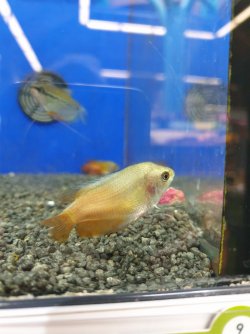Dwarf gouramis are one of the two most widely sold gouramis (the other being the three-spot gourami), and virtually every aquarium shop will sell them. They are generally peaceful, accept flake food readily, and are not fussy about water chemistry (though soft, acid water is best). However, despite being widely sold and seemingly easy to keep, they are in fact not easy fish at all. As with any pet animal, it pays to do your research first.
Latin name
Currently, the Latin name for these fish is
Colisa lalia. You will see other names though, such as
Polyacanthus lalius and
Trichogaster lalius.
Identifying dwarf gouramis
In their normal form, males are characterised by oblique red and blue stripes, while females are plain silver. There are a variety of artificial forms as well, including some that may be hybrids with other gourami species. These varieties include all-blue forms (sometimes called
neon,
blue, or
powder blue dwarf gouramis) and ones with a red body instead of the stripes (sometimes called
flame,
red, or
sunset dwarf gouramis). Females of all these artificial varieties are more or less plain silver and similar to the wild-type fish.
So what's the problem with dwarf gouramis?
Put simply, these fish are astonishingly prone to mysterious bacterial infections. Once the fish begin to get sick, death is more or less inevitable. The symptoms are typically:
1 - Lethargy
2 - Loss of appetite
3 - Appearance of bloody patches (sores) on the skin
4 - Death
Is this the same as Fish TB?
Though the external symptoms are similar to Fish TB, the problem with dwarf gouramis is caused by a completely different bacterium. Fish TB being primarily an issue with marine fish, not freshwater ones.
Fish TB is known to infect humans (albeit very rarely), but the
dwarf gourami sickness, whatever it is, poses no known risk to humans. However, it is a good idea to wash your hands after handling sick fish, or for that matter anytime after you have worked in your aquarium.
But I thought gouramis were hardy?
In the wild state, they are. But dwarf gouramis are bred on farms, where antibiotics have been used freely to minimise losses. Once shipped to the retailer, the dwarf gouramis no longer receive antibiotic medication, and the internal bacteria can then start to cause problems. Inbreeding for colour varieties has probably lowered their intrinsic hardiness as well.
What can I do?
Above all observe two rules:
only buy fish from tanks containing healthy specimens, Never, ever buy a dwarf gourami from a tank where there are sick, lethargic, or otherwise unhealthy-looking fish.
Secondly,
quarantine your fish rigourously. Dwarf gouramis should be quarantined before being added to the community tank, and any new gouramis (of any species) should be quarantined before being added to a tank with dwarf gouramis in it.
Anything else?
The bacteria seem to be opportunistic, so improving conditions generally helps prevent problems. Specifically, keep the water clean, and don't overstock the tank. Feed the fish on a varied diet, and use a good quality flake food as a staple. Dwarf gouramis like the water warm (25-28C, 77-82F); cooler conditions depress its immune system. Ideally, use soft, acid water, but whatever the water chemistry, perform frequent water changes. Do not combine with tankmates liable to stress the fish, such as tiger barbs, territorial cichlids, and so on. The less stressed the gouramis are, the healthier they are going to be.
Social behaviour
Like other gouramis, males can be aggressive towards females. Ideally, keep multiple females to every one male so that any aggression is spread out. However, since these fish are normally sold as pairs, you may not have that option. In this case, keep the tank thickly planted and provide lots of caves for the female to hide in. Do not keep a pair in a tank less than 60 cm in length (approx. 20 US gal.). Thanks to
Fillet 'O' Fish for this.
Cheers,
Neale

 /onlinelibrary.wiley.com/doi/10.1111/j.1365-2761.2010.01202.x/abstract;jsessionid=97F11328BB10D75CEEE0879A8F1F2F92.d02t01?systemMessage=Wiley+Online+Library+will+be+unavailable+for+approximately+4+hours+between+09%3A00+EDT+and+14%3A00+EDT+on+Saturday%2C+28+September+2013+as+we+make+upgrades+to+improve+our+services+to+you.+There+will+also+be+some+delays+to+online+publishing+between+25+to+28+September+2013.+We+apologize+for+the+inconvenience+and+appreciate+your+patience.+Thank+you+for+using+Wiley+Online+Library!&userIsAuthenticated=false&deniedAccessCustomisedMessage=
/onlinelibrary.wiley.com/doi/10.1111/j.1365-2761.2010.01202.x/abstract;jsessionid=97F11328BB10D75CEEE0879A8F1F2F92.d02t01?systemMessage=Wiley+Online+Library+will+be+unavailable+for+approximately+4+hours+between+09%3A00+EDT+and+14%3A00+EDT+on+Saturday%2C+28+September+2013+as+we+make+upgrades+to+improve+our+services+to+you.+There+will+also+be+some+delays+to+online+publishing+between+25+to+28+September+2013.+We+apologize+for+the+inconvenience+and+appreciate+your+patience.+Thank+you+for+using+Wiley+Online+Library!&userIsAuthenticated=false&deniedAccessCustomisedMessage=